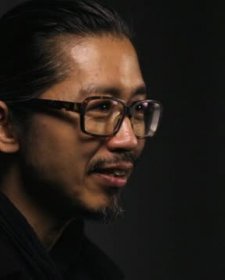When I look back, being a teenager growing up in a traditional city in Japan called Kyoto, I felt I was a bit of a fashion victim, really. Well now actually I create fashion. But back then, actually, I was consuming fashion and that's how much I loved [it].
Japanese culture is so different from Western ones. My grandparents had a house next door. They were all wearing actually traditional clothes – kimono. What I noticed about kimono is actually they're made out rectangular shaped cloth. And they have no shapes. Whereas actually, Western clothes has a particular shape that enhance, particularly actually for female, the femininity of female body, but whereas actually kimono is totally unisex. I mean, I've never actually designed kimono myself. But being a kimono designer, I imagine actually, they work on texture, colour, print, and so on, because it's a highly textile driven fashion, and then to me, that's what Japanese fashion is all about. You know, when I design my own collection, I never really force myself to express my Japanese entity, but I feel that it just comes up naturally. And I think what's interesting is that not just, you know, designing something so traditionally Japanese, but then I kind of actually manage to fuse with Australian ease I guess actually. Australia has got this particular attitude – friendly to start with – but it's quite actually casual about things, you know. I feel actually my design is a result of actually, you know, some Japanese heritage with Australian attitude, which is actually friendly and easy.
Audio: 2 minutes 4 seconds
When I look back, being a teenager growing up in a traditional city in Japan called Kyoto, I felt I was a bit of a fashion victim, really. Well now actually I create fashion. But back then, actually, I was consuming fashion and that's how much I loved [it].
Japanese culture is so different from Western ones. My grandparents had a house next door. They were all wearing actually traditional clothes – kimono. What I noticed about kimono is actually they're made out rectangular shaped cloth. And they have no shapes. Whereas actually, Western clothes has a particular shape that enhance, particularly actually for female, the femininity of female body, but whereas actually kimono is totally unisex. I mean, I've never actually designed kimono myself. But being a kimono designer, I imagine actually, they work on texture, colour, print, and so on, because it's a highly textile driven fashion, and then to me, that's what Japanese fashion is all about. You know, when I design my own collection, I never really force myself to express my Japanese entity, but I feel that it just comes up naturally. And I think what's interesting is that not just, you know, designing something so traditionally Japanese, but then I kind of actually manage to fuse with Australian ease I guess actually. Australia has got this particular attitude – friendly to start with – but it's quite actually casual about things, you know. I feel actually my design is a result of actually, you know, some Japanese heritage with Australian attitude, which is actually friendly and easy.
Acknowledgements
This recording was made during interviews for the National Portrait Gallery's Portrait Stories series.
Related people
Related information



Akira Isogawa
Inside the patterns
Portrait storyIconic Australian fashion designer, Akira Isogawa discusses the development of his unique style.



The Gallery
Visit us, learn with us, support us or work with us! Here’s a range of information about planning your visit, our history and more!



Support your Portrait Gallery
We depend on your support to keep creating our programs, exhibitions, publications and building the amazing portrait collection!




